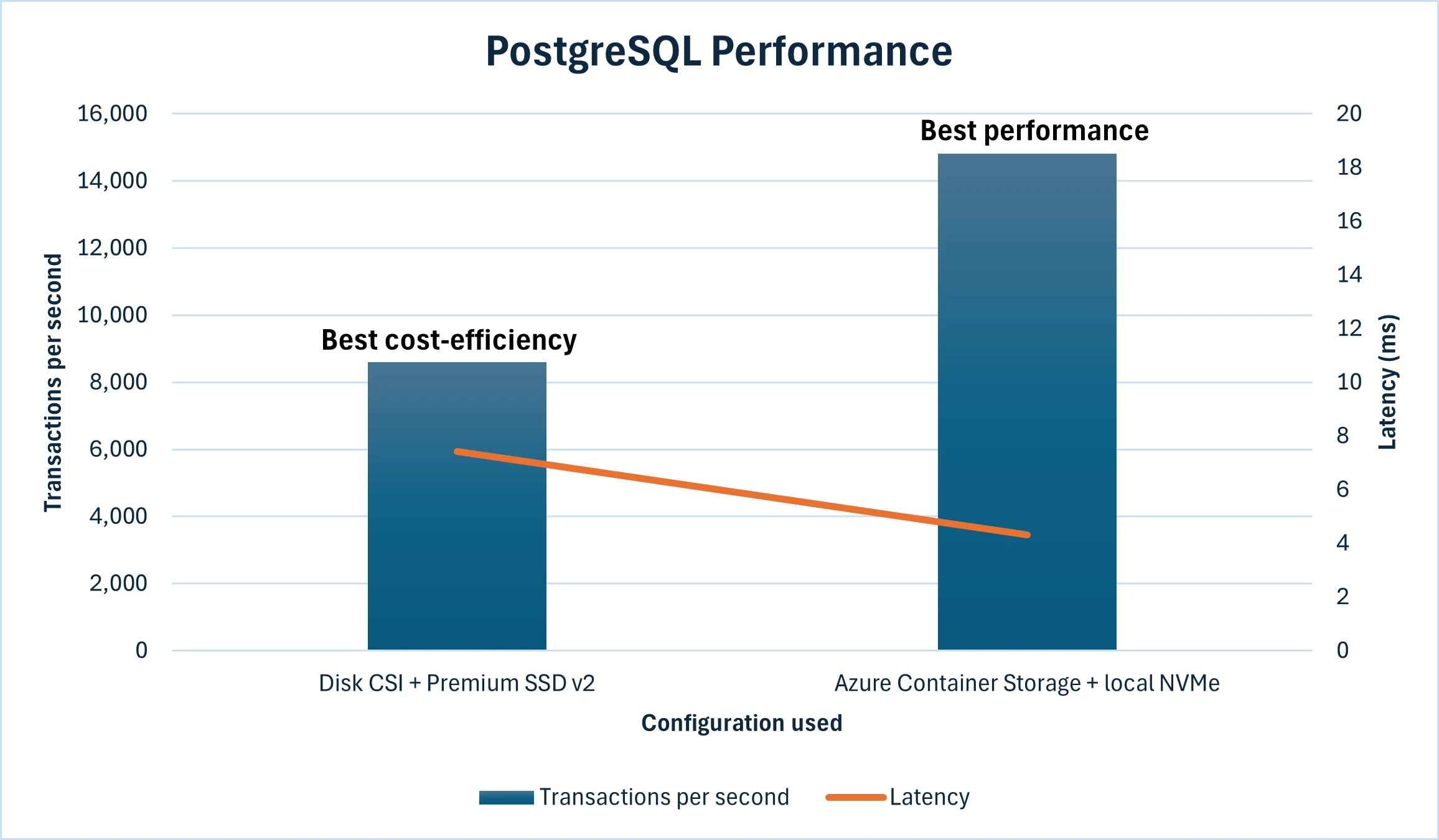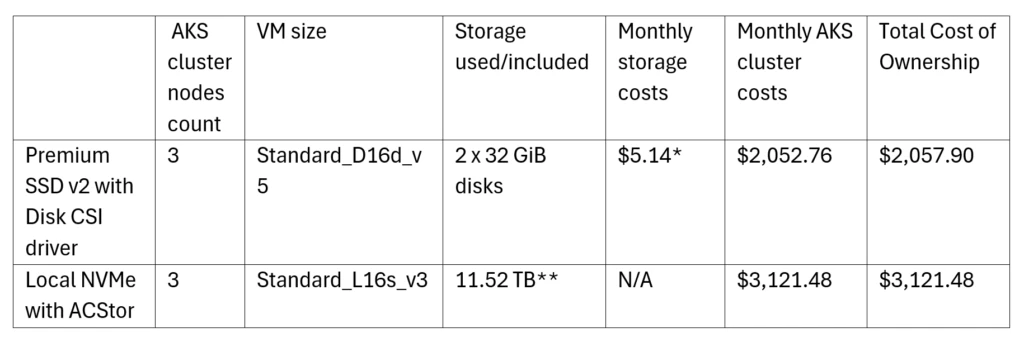
PostgreSQL continues to solidify its position as a top-tier database choice among workloads running on Kubernetes.
In the ever-evolving world of cloud-native technologies, PostgreSQL continues to solidify its position as a top-tier database choice among workloads running on Kubernetes. According to the Kubernetes in the Wild 2025 report, PostgreSQL now powers 36% of all database workloads running on Kubernetes—up 6 points since 2022—signaling its rising popularity and growing trust among the Kubernetes community1. However, running data-intensive PostgreSQL workloads on Kubernetes has its own set of challenges. These include managing Kubernetes primitives like StatefulSets and deployments, as well as achieving optimal performance by configuring storage, replication, and database settings, but this is fast evolving to a simplified experience.
We now provide two options for deploying stateful PostgreSQL workloads based on performance needs. To support databases with stringent latency and scalable transaction requirements, you can leverage Azure Container Storage to orchestrate Kubernetes volume deployment on local NVMe to scale up IOPS while maintaining extremely low sub-ms latency. For scenarios where optimized price-performance is a priority, Premium SSD v2 is the go-to choice. Additionally, working with CloudNativePG, we integrated a robust open-source operator for PostgreSQL to support a high availability database deployment model on Azure Kubernetes Service (AKS). Our advanced storage options combined with CloudNativePG make AKS a robust platform for high-performance PostgreSQL workloads.
Breakthrough PostgreSQL performance with local NVMe
For performance-critical PostgreSQL workloads, such as those handling massive concurrent transactions or demanding, low-latency data access, local NVMe directly attached to Azure Virtual Machine (VM) SKUs is your best bet. Using local NVMe drives with Kubernetes used to be complicated—it often required setting up RAID across the drives and manually managing static volume orchestrators. Azure Container Storage effectively addresses this challenge.
Azure Container Storage is a fully managed, container-native storage solution, designed specifically for Kubernetes. Developers can simply request a Kubernetes volume, and Azure will dynamically provision storage backed by the available local NVMe drives on AKS nodes. This gives PostgreSQL users direct attach block storage IOPS and latency within a managed, orchestrated cloud environment. Whether you’re powering payment systems, gaming backends, or real-time personalization engines, you get the best of both speed and simplicity. Azure Container Storage also supports Azure Disk and Elastic SAN (Preview), so you can choose backing storage with different durability, scale, or cost as your needs evolve—all under a consistent, Kubernetes-native control plane.
Our benchmark results have shown PostgreSQL achieving close to 15,000 transactions per second (TPS) with single-digit millisecond end-to-end query latency with the Standard_L16s_v3 VM. When scaling up to larger VM SKUs like Standard_L64s_v3, we observed TPS reaching up to 26,000 while maintaining low latency. For more details of our benchmark runs, refer to the comparison of storage options section below.
Optimize price-performance with Premium SSD v2
Azure Premium SSD v2 offers an optimal balance of price-performance and a flexible deployment model, making it especially well-suited for production environments that need to scale over time. With Premium SSD v2, you can configure IOPS, throughput, and size independently—enabling PostgreSQL deployments to scale dynamically with demand while minimizing upfront costs and avoiding resource overprovisioning.
Whether you’re running multi-tenant SaaS platforms, production systems that scale with business needs, or applications with spiky traffic, this flexibility leads to real savings without sacrificing performance. With up to 80,000 IOPS and 1,200 MB/s per volume, Premium SSD v2 supports highly demanding PostgreSQL workloads on an infrastructure that adapts to your app.
Comparison of storage options
To help you assess the two storage options outlined above, we conducted benchmark runs using the CloudNativePG operator setups on AKS with similar core and memory consumption, with both backing storage options as the only variable: one leveraging local NVMe with Azure Container Storage, and the other using Premium SSD v2 with Disk CSI driver.
For the first configuration, we used Standard_D16d_v5 SKU and provisioned two Premium SSD v2 32 GiB disks each having 3000 IOPS and 125 MB/s throughput for log and data files. In the second setup, we ran on Standard_L16s_v3 nodes with local NVMe storage included. The test environment was configured to closely simulate a real-world production database scenario. TPS measures how many individual transactions (such as INSERT, UPDATE, DELETE, or SELECT) a system can handle per second. Latency refers to the time delay between issuing a request to the database and receiving a response, which is especially critical for applications requiring real-time or near-real-time responsiveness, such as financial systems, online gaming, or high-performance analytics.

Local NVMe on Standard_L16s_v3 delivered 14,812 TPS with an average latency of 4.321 milliseconds. PremiumV2_LRS on Standard_D16ds_v5 recorded 8,600 TPS at 7.417 milliseconds latency. See pricing comparison below:

*Monthly costs are based on the base 3000 IOPS and 125 MB/s throughput. You can adjust the performance (capacity, throughput, and IOPS) of Premium SSD v2 disks at any time, allowing workloads to be cost efficient while meeting workload size and performance requirements.
**With 3 VMs of L16s_v3, you get 11.52 TB of storage allocated by default that is used to serve the volumes created for PostgreSQL workload. For other VM sizes in the L-Series family, the price per month and allocated storage will vary.
For PostgreSQL workloads, the choice between using local NVMe and Premium SSD v2 depends on balancing performance, cost, and data durability. Local NVMe via Azure Container Storage offers extremely low latency and high throughput, making it suitable for performance-sensitive PostgreSQL deployments. The costs are higher with local NVMe, and there is less flexibility to scale independently of workload characteristics. Conversely, Premium SSD v2 provides better price-performance efficiency and flexible scalability, making it a viable option for PostgreSQL instances that require handling increased scale or applications having unpredictable surges in demand or usage. In terms of data durability, Premium SSD v2 offers locally redundancy by default, while for local NVMe, it is recommended to use a replica-based architecture managed by CloudNativePG operator and an object storage-based backup approach to prevent data loss.
Built for high availability with CloudNativePG on Azure Kubernetes Service
For teams deploying PostgreSQL in production, high availability and backups are non-negotiable. With the open-source CloudNativePG operator, a highly available PostgreSQL cluster on AKS can easily be deployed with:
- Built-in replication and automated failover.
- Application consistent backup with native integration with Azure Blob Storage.
- Seamless integration with Azure Container Storage.
- Flexible storage options: choose Premium SSD v2 or local NVMe based on workload needs.
Whether you’re supporting internal business apps or customer-facing platforms, this gives you peace of mind without the hassle of hand-building custom high availability logic and separate backup workflows. Get started with deploying highly available PostgreSQL on AKS with CloudNativePG operator using our step-by-step reference guide.
Ready for the future
PostgreSQL is just one of many stateful workloads that organizations are now confidently running on Azure Kubernetes Service. From databases to message queues, AI inferencing, and enterprise applications, AKS is evolving to meet the needs of persistent, data-heavy applications in production.
Whether you’re deploying Redis, MongoDB, Kafka, or even ML-serving pipelines with GPU-backed nodes, AKS provides the foundation to manage these workloads with performance, consistency, and operational ease, along with clear end-to-end guidance.
With innovations like Azure Container Storage for local NVMe and Premium SSD v2 for scalable persistent storage, we’re making it easier than ever to build stateful applications that are: reliable, performant, and cost efficient for mission critical workloads.
Modernize your data layer on Kubernetes today. Whether you’re running PostgreSQL or any stateful tier, Azure delivers the performance and manageability to make it happen. Explore proven patterns and deployment options in the AKS Stateful Workloads Overview.
1Kubernetes in the Wild 2025 report




